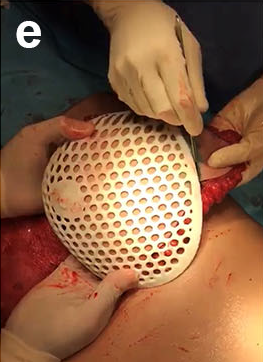Dr. Horacio Mayer
Hospital Italiano - Buenos Aires, Argentina
Benefits
✔ Facilitates flap shaping
✔ More symmetrical results with high reconstructive quality
✔ Shorter surgery time
✔ Avoids the need for surgical touch-up of the reconstructed breast
✔ Avoids or reduces the need for symmetry in the healthy breast

Clinical case
A 59-year-old female patient was diagnosed with infiltrating ductal carcinoma of the right breast.
Because of this, she underwent a breast-conserving tumour resection operation, together with radiotherapy and chemotherapy treatment.
Due to recurrence of the carcinoma, a mastectomy of the right breast was necessary. Some time later, the patient was offered an autologous abdominal-based breast reconstruction with TRAM flap (Transverse Rectus Abdominal Musculocutaneous Flap) and the use of breast moulds to optimise the results.
3D mould design
To generate the 3D printed mould, it was necessary:
1. Perform a 3D scan of the patient's torso to obtain the image of the healthy breast. This is done with a specialised application for plastic surgeons.
2. With the same application, create the projection of the breast to be reconstructed by digitally mirroring the healthy breast.
3. Based on the information of the projected breast, create a specific three-dimensional mould using design software.
4. 3D print the mould and sterilise it under all biosafety conditions for use in surgery.
3D anatomical mould
◾ FDM technology
◾ Material: PLA
◾ Resolución: 0.2 mm
◾ Finish: One color
Surgical plan and results in operating room
In breast reconstruction surgery, the 3D mould was used to facilitate the modelling of the abdominal dermoadipose flap in volume, shape and orientation.
This innovative technique makes it possible to increase the precision of the reconstruction and the symmetry between breasts in a single surgery, avoiding having to carry out subsequent interventions to retouch both the healthy breast and the reconstructed breast, a very common situation in this field.
You may be interested in: "Facial reconstruction with 3D mask for burn patient". 3D printing has a high impact on reconstructive plastic surgery. Read this success story of Dr. Mayer and Dr. Aguilar at the Hospital Italiano de Buenos Aires.
The procedure was performed in less time due to a faster flap shaping process, and the result was considered highly satisfactory for both the surgeon and the patient.
Between 15% and 20% of women who undergo breast reconstruction are candidates for autologous reconstruction, and would benefit from this new method using 3D moulds.
Published paper: The Use of a 3D Simulator Software and 3D Printed Biomodels to Aid Autologous Breast Reconstruction - Horacio F. Mayer, MD, FACS






















